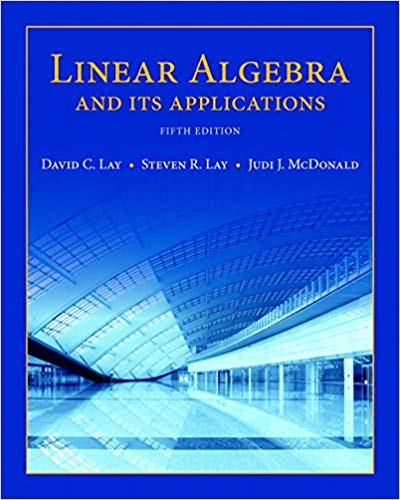
Linear Algebra and Its Applications, 5th Edition
Authors: David C. Lay, Steven R. Lay, Judi J. McDonald
ISBN-13: 978-0321982384
We have solutions for your book!
See our solution for Question 23E from Chapter 5.1 from Lay's Linear Algebra and Its Applications, 5th Edition.
Problem 23E
Chapter:
Problem:
Explain why a 2 × 2 matrix can have at most two distinct eigenvalues. Explain why an n × n matrix can have at most n distinct eigenvalues.
Step-by-Step Solution
Given Information
We have to prove that why a $2 \times 2$ matrix can have at most two distinct eigenvalues. We also have to explain why an $n \times n$ matrix can have at most $n$ distinct eigenvalues
Step-1:
The eigenvector theorem states that the Eigen vectors ${v_1, v_2..v_p}$ corresponding to distinct Eigen values {$\lambda _ { 1 } , \ldots , \lambda _ { n }$} of an matrix, then the set ${v_1, v_2..v_p}$ is linearly independent. If we assume that a $2 \times 2$ matrix has three eigenvalues, then there must be three eigenvectors.
Since the matrix has vectors in $R^2$, the set ${v_1, v_2..v_p}$ must be linearly dependent if $p>n$. Here p is 3 and n is 2. Therefore,
The $2 \times 2$ matrix can have at most two distinct eigenvalues
Step-2:
Similar to the theory given above, if a $n \times n$ matrix has p different eigenvalues, then these p vectors are independent eigenvectors. Since the eigenvectors belong to $R^n$, hence p cannot exceed $n$
The $n \times n$ matrix can have at most n distinct eigenvalues
We have to prove that why a $2 \times 2$ matrix can have at most two distinct eigenvalues. We also have to explain why an $n \times n$ matrix can have at most $n$ distinct eigenvalues
Step-1:
The eigenvector theorem states that the Eigen vectors ${v_1, v_2..v_p}$ corresponding to distinct Eigen values {$\lambda _ { 1 } , \ldots , \lambda _ { n }$} of an matrix, then the set ${v_1, v_2..v_p}$ is linearly independent. If we assume that a $2 \times 2$ matrix has three eigenvalues, then there must be three eigenvectors.
Since the matrix has vectors in $R^2$, the set ${v_1, v_2..v_p}$ must be linearly dependent if $p>n$. Here p is 3 and n is 2. Therefore,
The $2 \times 2$ matrix can have at most two distinct eigenvalues
Step-2:
Similar to the theory given above, if a $n \times n$ matrix has p different eigenvalues, then these p vectors are independent eigenvectors. Since the eigenvectors belong to $R^n$, hence p cannot exceed $n$
The $n \times n$ matrix can have at most n distinct eigenvalues